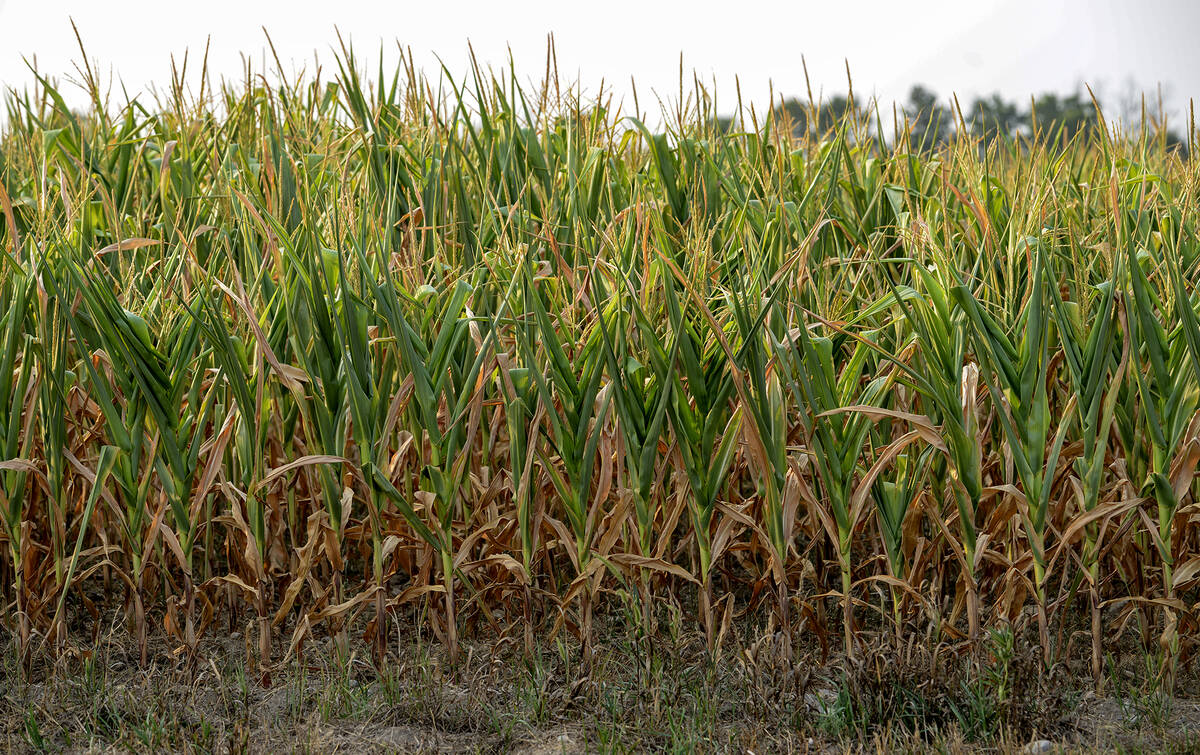As of Oct. 5, the Ontario soybean harvest was approximately 60 per cent complete while the corn harvest was in the early stages. Intermittent showers are in the forecast for the first half of October.
We’re in the process of getting a better handle on crop quality. Yield results confirm our production forecast. Basis levels for corn and soybeans are expected to remain under pressure throughout October due to heavy farmer selling.
However, soybean and corn exports will increase during November and December. This will alleviate congestion in the Ontario commercial pipeline.
Read Also

Extreme variability marks Ontario’s 2025 corn crop
The yield potential of Ontario’s 2025 corn crop was lost in some areas due to extreme dry conditions.
Quick look:
Soybeans: Ontario farmers have been steady sellers off the combine, which has softened local demand.
Corn: U.S. energy policy will have a significant effect on corn in the next year.
Wheat: About 30 per cent of Ontario’s wheat crop was feed grade in 2021.
The USDA Sept. 1 stocks report was considered bearish for corn and soybeans. The corn and soybean futures are absorbing Northern Hemisphere harvest pressure. The forecast across the Midwest looks mostly favorable for harvest progress. We don’t expect significant delays.
Chinese demand has been evident for U.S. soybeans but not for corn. Terminals in the U.S. Gulf are slowly coming back on stream after Hurricane Ida. Seeding is in the early stages in South America. Recent rains in Brazil have enhanced crop prospects. The first crop corn in Brazil is being planted under optimal conditions. Argentina has also received timely precipitation.
Winter wheat seeding is underway in the U.S., Europe, Russia and Ukraine. Russia remains on the dryer side. The U.S. wheat production estimates were considered bullish for the wheat market. There is a fair amount of open demand for wheat with tenders from major importers over the past couple weeks.
The December Canadian dollar continues to consolidate with support at 78 U.S. cents and resistance at 80 U.S. cents. Crude oil fundamentals are bullish, which will be supportive for the Canadian dollar and grain and oilseed markets.
China and Europe are facing an energy crisis. U.S. crude oil inventories are sharply below the seven-year average. This is the “silent creeper” that could surprise the commodity complex. We could see $100 crude oil by the late winter period depending on OPEC and Russian production schedules.
Quantitative easing by the U.S. Federal Reserve and Bank of Canada will likely be wrapped up by the second quarter of 2022. Higher Canadian bond yields versus their U.S. counterparts support Canadian dollar appreciation against the greenback longer term. We’re turning a corner on the Canadian dollar. Our view is neutral to bullish.
Soybeans
Ontario soybean prices have been hovering in the range of $15-$15.50/bu. over the past month. Values are in line with the world market, which has kept elevator bids well supported. Exports will increase in November but the lack of offshore movement in the short term has limited the upside.
Domestic demand is somewhat sluggish due to weaker bean oil and soymeal prices. There is limited demand for Ontario soybeans for October. We continue to forecast an Ontario soybean crop of 4.4 million tonnes, up from the 2020 output of 3.9 million tonnes. Farmers have been steady sellers off the combine, which has also contributed to the softer tone.
U.S. soybean prices in the Midwest have been grinding lower over the past month. The U.S. fundamentals are not as tight as earlier anticipated. First, U.S. soybeans stocks as of Sept. 1 came in at seven million tonnes, up from the USDA WASDE number of 4.7 million tonnes. Remember, earlier in spring we thought the U.S. carryout would drop to three million tonnes.
Secondly, the USDA had soybean production at 119 million tonnes on the September WASDE report. There is an old saying that big yields tend to grow through harvest. We could see the U.S. soybean crop finish in the range of 120-121 million tonnes. The U.S. export pace was slower than expected through September because of the damage from Hurricane Ida in the Gulf.
China is coming back to the U.S. origin for November through February requirements but the U.S. has lost some demand. Compared to last month, the U.S. has larger carrying stocks, larger production and lower demand. This is bearish. The market is not getting bullish but bearish. Keep in mind we’re looking for a year-over-year increase in South American soybean production.
What to do: In this week’s issue, we’re advising Ontario farmers to sell 20 per cent of their 2021 production, bringing total sales to 40 per cent. There is a small carrying charge in the market so producers may want to sell now for early November delivery. We still have 60 per cent of the crop left if adverse conditions develop in South America but we feel it’s prudent to increase sales given the current fundamentals.
Corn
The Ontario corn crop is expected to finish near 9.6 million tonnes, up from the 2020 output of 8.9 million tonnes and up from the five-year average crop size of 8.7 million tonnes. There are private forecasts in the range of 10.0-10.5 million tonnes. Supplies of corn will be burdensome throughout the fall period and the market will function to encourage demand.
The major destination of Ontario corn during the 2020/21 crop year was Ireland and Spain. Without going into detail, Ontario corn delivered into these two countries was priced at a slight discount to French corn. This is the major competitor. U.S. corn out of the Gulf will only be available in December and it is premium to Ontario and French origin. France has a larger feed wheat crop this year, which is weighing on the European feed grain complex.
The USDA estimated U.S. Sept. 1 stocks at 31.4 million tonnes, up from its latest WASDE projection of 30.1 million tonnes. The futures shrugged off the increase because a 1.3 million tonne difference is rather small in the grand picture. The focus is on harvest progress, export demand and ethanol use. At this stage, it appears that harvest will occur without any major hiccups. The weather forecast looks promising.
On the export side, Chinese demand has been absent since spring. China will likely buy additional volume later in winter but it will not be as large as last year. The Chinese corn crop is estimated at 273-275 million tonnes, up from the 2020 crop size of 261 million tonnes. The larger Chinese crop will result in lower import demand. It’s going to take time for exports to catch up out of the U.S. Gulf. In the Southern Plains, corn is more competitive than wheat. Cattle on feed inventories will increase. The feed component is the price floor for corn and is fairly solid.
U.S. crude oil inventories are the lowest since 2014. The Biden Administration is considering big cuts to the biofuel blending mandate. Given the current environment, energy policy and prices will be the main factors influencing U.S. and Ontario corn values for 2021/22. At this stage, stronger crude prices will continue to underpin North American corn prices.
What to do: We’ve advised producers to be 20 per cent sold on their 2021 production. This week, we’re advising producers to sell an additional 10 per cent of their 2021 crop, bringing total sales to 30 per cent. Given the larger Ontario crop size, we need to increase the overall volume of sales. We’re looking to make our next sales recommendation in November.
Wheat
The wheat market is percolating higher due to tight fundamentals from major exporters along with seasonally strong demand. We feel comfortable with Statistics Canada’s Ontario winter wheat production estimate of 2.6 million tonnes, up from the 2020 output of 2.3 million tonnes.
The jury is still out on how much of the crop is milling quality but at this stage we feel comfortable that 30 per cent of the crop is feed. Given the year-over-year increase in feed, we have lower milling quality supplies in Ontario. We’re forecasting Canadian hard red spring production at 14 million tonnes, down from 25 million tonnes last year.
The USDA lowered its winter wheat production estimate on the small grains survey. U.S. soft red winter wheat took a haircut from 10 million tonnes to 9.8 million tonnes. We’re forecasting the U.S. soft red winter wheat carryout to drop to historical lows for the 2021/22 crop year.
U.S. hard red winter wheat production was trimmed from 21.1 million tonnes down to 20.3 million tonnes. Without going into detail of demand, we’ now projecting a U.S. hard red winter wheat carryout of nine million tonnes, down from the five-year average of 14.3 million tonnes. This is fairly snug for hard red winter.
In Russia, the government has a floating export tax in efforts to control the export pace. This is keeping cash values elevated in the Black Sea. Russia’s crop will likely finish around 72 million tonnes, down from the 2020 crop of 85.3 million tonnes. Russia is the world’s largest wheat exporter so this has a major effect on the market with the tariffs.
The Ukraine crop at 33 million tonnes is up from last year’s output of 25.4 million tonnes. Ukraine will be an active exporter in the first half of the crop year but the government will curb exports in the latter half of the year to limit food inflation.
EU wheat output will be 139 million tonnes, up from the 2020 crop of 126 million tonnes. A large portion of the French crop is feed. Germany also suffered adverse rains. Milling supplies are down from year-ago levels.
Over the last couple weeks, the market is incorporating a risk premium due to uncertainty in supplies of milling quality wheat. At the same time, major importers have held large tenders, absorbing exportable surplus. We’re planning to make our next sale in early November.
What to do: This week, we’re advising producers to sell an additional 20 per cent of the 2021 milling supplies, bringing total sales to 40 per cent. If you have feed supplies, we’ve advised producers to move 30 to 50 per cent of their feed wheat production. We want to sell into this recent strength. Once the demand subsides, the market could be vulnerable to a major pullback.













